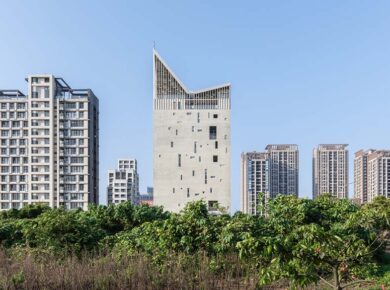Situated in San Cristobal de la Laguna, Spain, The Holy Redeemer Church stands as a testament to architectural innovation and community collaboration. Designed by Fernando Menis, the construction of this church spanned over fifteen years, coinciding with the revitalization of the Las Chumberas neighborhood. This neighborhood, comprising 670 homes across 42 blocks, underwent significant urban and social transformations, with The Holy Redeemer Church serving as a pivotal catalyst for change.
![]()
Architectural Vision
Fernando Menis envisioned the church not just as a religious space but as a cornerstone of community identity and urban renewal. The complex comprises the church itself, a community center, and a public square, offering a much-needed gathering place for the neighborhood residents. Funding for the project came from various sources, including donations from organizations, residents, and local businesses committed to the neighborhood’s development.
Design Concept
Drawing inspiration from the island’s volcanic geology, the building’s design reflects the rugged beauty of its surroundings. Four massive volumes, resembling restless rocks, emerge from the ground, creating a striking contrast with the conventional residential context. Narrow cracks filled with sculptural metal and glass structures allow daylight to penetrate the building, creating an austere yet captivating interior.
Lighting and Acoustics
Daylight plays a crucial role in shaping the church’s interior, symbolizing spiritual renewal and progression through Christian sacraments. Strategically placed skylights illuminate specific areas, emphasizing the significance of each ritual. Additionally, Menis explores the acoustic potential of concrete, demonstrating that it can rival traditional materials like wood. Concrete surfaces, enriched with porous volcanic stone, create optimal acoustics suitable for both ecclesiastical and social functions.
![]()
Recognition and Awards
The Holy Redeemer Church has garnered international acclaim for its architectural excellence. Visited by renowned figures like Barry Bergdoll, the project has been included in the Museum of Modern Art’s architecture collection. Most notably, it received the Faith & Form International Award for Religious Art and Architecture, highlighting its innovative use of light, texture, and acoustics to create spiritual spaces that resonate with warmth and intimacy.
Conclusion
As a beacon of transformation, The Holy Redeemer Church stands as a testament to the power of architecture to inspire social change and community cohesion. Its innovative design, rooted in local context and collective action, continues to enrich the lives of residents and visitors alike, fostering a sense of belonging and spiritual renewal in the heart of San Cristobal de la Laguna.
























